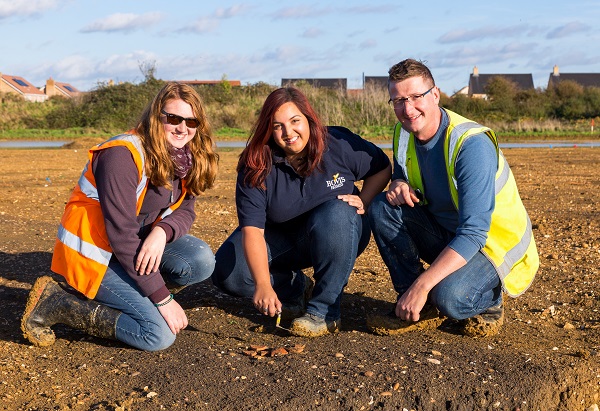Archaeology fans in Sawtry enjoy special tour at housebuilder location
- 06 Dec 19
Archaeology enthusiasts in Sawtry enjoyed getting up close to Roman pottery and glass on a
special tour at a housebuilder’s location – and the earliest remains dated back further, to the Iron Age!
Bovis Homes' Debbie Rigger with a small trowel at the Sawtry location
Participants visited the excavation area, off Gidding Road, as part of the Sawtry Archaeological Excavation Guided Tour and met Bovis Homes colleagues and archaeologists from Oxford Archaeology East.
The visitors – who included local residents – were given a guided tour of the site by one of the archaeologists working there and got the chance to handle some of the finds discovered on their doorstep.
Debbie Rigger, marketing co-ordinator at Bovis Homes, said: “Everyone had a fantastic time on our guided tour of the excavation site – it was hugely informative and everyone could touch and find out more about a variety of fascinating items.
“It was a great experience to see and touch the array of Roman artefacts found on the site, and to speak to the archaeologists personally about what they found here and how they plan their excavations.
“The archaeologists showed me how they, with such a small trowel, uncover the most delicate of buried items such as the small Roman brooches with all their detail and artistry.
“There were all sorts of facts about the animal bones too – like horse teeth never stop growing throughout a horse’s life!”
The earliest remains on the site are from a small Iron Age farmstead dating back to 350-50 BC. Romans later settled on the site.
Matt Brudenell, senior project manager at Oxford Archaeology East, said: "It was wonderful to show local residents around the location. The archaeological excavations at the Sawtry site have revealed evidence of settlement dating back over 2,000 years.
“The earliest remains relate to a small Iron Age farmstead with roundhouses and stock enclosures dating 350-50 BC. This was replaced by a larger Roman settlement located on higher ground towards Gidding Road, laid out along a trackway.
“No structures survived, but a series of ditched paddocks, enclosures and gullies were revealed either side of the trackway, as well as gravel extraction pits and large waterholes.
“Finds recovered from the settlement suggest Roman activity was focused on the period between mid-first to mid-third century AD.
“They include pottery, animal bone, shell, fired clay, but also fragments of glass and two cooper alloy brooches. The settlement was a farm and may have specialised in livestock rearing.”
After the excavation, Oxford Archaeology East will weigh and catalogue all the archaeological artefacts found and they will be sent to specialists for analysis.
Results of the excavation will be submitted to the Cambridgeshire Historic Environment Record - a public record of the county's archaeology.



Share this with
These are external links and will open in a new window